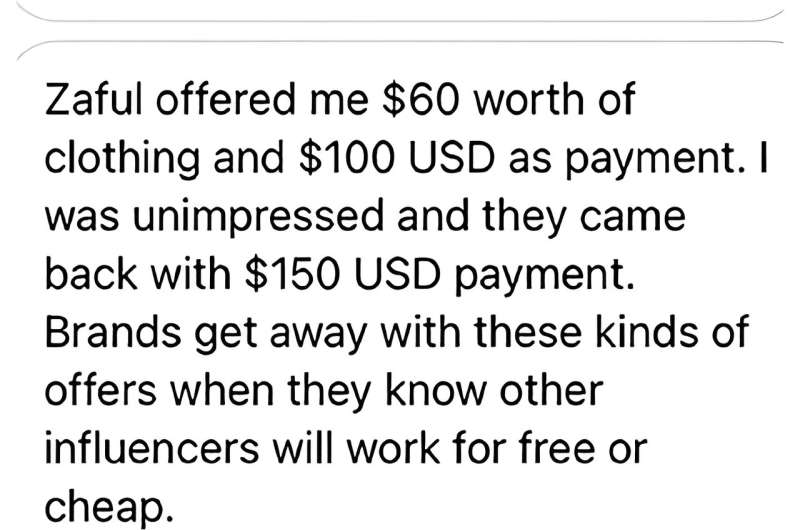This article has been reviewed according to Science X's editorial process and policies. Editors have highlighted the following attributes while ensuring the content's credibility:
fact-checked
peer-reviewed publication
trusted source
proofread
Avoiding the gifts-in-kind trap: New research shows how influencers can make their work pay

Social media influencers who want to be paid money for their content must focus on three key areas to lift themselves out of the gifts-in-kind trap and to protect their pursuit of meaningful work, new research from the University of Bath shows.
Influencers—who create online content to engage users in commercial transactions in a global industry estimated to be worth $13.5 billion—often struggle to circumvent expectations that they will perform free labor for brands or settle for gifts-in-kind instead of hard cash, researchers said.
"There are around 50 million influencers worldwide and it is increasingly seen as a desirable career for people who want to pursue meaningful work and also get paid for what they love doing. But the stark reality is most are doing it for free or settling for gifts-in-kind or promises of future exposure. The big challenge is making it viable," said Dr. Sarah Glozer of the University of Bath School of Management.
The study, co-authored by Dr. Hannah Trittin-Ulbrich from Leuphana University Lüneburg, noted that this was also complicated by some influencers struggling to reconcile the pursuit of pay with work that may have started as a hobby or a personal passion and failing to understand how to value their contribution commercially.
"Many influencers prioritize meaningful work—work that holds personal significance and personal worth—over paid work. However, what if influencers do not wish to sacrifice pay for meaningful work?" Dr. Glozer said.
Dr. Glozer said the study identified three key elements that enabled influencers to move away from producing commercial content for free: authenticity; relationality—or building connections and networks; and quantification—the effective use of data and metrics to assess impact and make the case to big brands and companies.
"The key is to combine all three elements—our research suggests commercial success won't follow if only one or two of these conditions are met," she said.
The research drew on interviews with 19 influencers who participated in the InfluencerPayGap (IPG) community, an Instagram profile established in 2020 to expose pay disparities and discriminatory practices in the influencer industry. The team observed the IPG community and extracted 1087 posts and over 24,000 comments submitted between June 2020 and March 2021, and also undertook six interviews with companies that employ influencers.
"Authenticity was highly prized. We found this emerging profession to be strongly characterized by a widespread commitment to creating 'authentic' high-quality content—influencing provided personal fulfillment, enriching their lives, and, in some cases, safeguarding their mental health. This also is attractive to companies engaging with influencers, who put a high value on who the influencers are and the content they produce," Dr. Glozer said.
Authenticity also had a strong bearing on the second factor for success—relationality.
"Influencers were vividly aware of their roles as 'hybrid salespeople' and the need to build connections with their followers to enrich the market worth of their work and to keep those engagement rates high. But it's a tricky balancing act—their followers are wary of them becoming too commercial and losing their authenticity," Dr. Glozer said.
She said their research showed authenticity and human connection mattered deeply to many influencers, who talked passionately about the friendships they had built with their followers, connections that made the influencers more commercially viable but also enhanced the meaning of their work.
Thirdly, successful influencing demanded quantification. Dr. Glozer noted that most influencers consistently—even obsessively—measured social media metrics facilitated by platform algorithms, such as 'follower counts'.
Crucially, this quantification provided hard facts and figures for media kits or rate cards, which could be used to negotiate commercial value with brands. Successful influencers would also strive to develop their commercial acumen and knowledge of social media to know what to measure, she said.
"There is, however, a dark side to this quantification. The Holy Grail of influencing is passing the 10,000-follower mark, when influencers can use the 'swipe up' feature on Instagram to add links directly to their stories. This can lead many to feel that they can't demand payment for their work before that point," Dr. Glozer said.
The findings are published in the journal Human Relations.
More information: Hannah Trittin-Ulbrich et al, #Knowyourworth: How influencers commercialise meaningful work, Human Relations (2024). DOI: 10.1177/00187267231220260
Journal information: Human Relations
Provided by University of Bath



















